- Home
- Colleen McCullough
On, Off Page 4
On, Off Read online
Page 4
“Rats in the main, but I do Sherringtonian decerebrations on cats too.”
“What’s that?” he asked, writing in his notebook, but not really wanting to know — more abstruse details coming up!
“Removal of a brain from the tentorium up under ether anesthesia. The moment I shell the brain out, I inject Pentothal into the heart and wham! the animal’s dead. Instantaneous.”
“So you put fairly large animals into bags and take them to the refrigerator for disposal?”
“Yes, on decerebration days.”
“How often do these decerebration days happen?”
“It depends. If Dr. Ponsonby or Dr. Polonowski asks for cat fore-brains, about every two weeks for a couple of months, at the rate of three to four cats on any one day. Dr. Satsuma doesn’t ask nearly as often — maybe once a year, six cats.”
“How big are these decerebrated cats?”
“Monsters. Males about twelve to fifteen pounds.”
Right, two floors down and two to go. Utilities, workshops and neurophysiology done. Now it’s up to see the office staff on the fourth floor, then down to the third and neurochemistry.
There were three medical typists, all with science degrees, and a filing clerk who had nothing more imposing than a high school diploma — how lonely she must feel! Vonnie, Dora and Margaret used big IBM golfball typewriters, and could type “electroencephalography” faster than a cop could type “DUI.” Nothing there; he left them to it, Denise the filing clerk sniffling and mopping her eyes as she peered into open drawers, the typewriters clattering like machine guns.
Dr. Charles Ponsonby was waiting for him at the elevator. He was, he said to Carmine as he escorted the visitor to his office, the same age as the Prof, forty-five, and filled in for the Prof when he was away. They’d gone to the Dormer Day School together, did their premed at Chubb together, then their medical degrees at Chubb. Both, Ponsonby explained gravely, were Connecticut Yankees back to the beginning. But after medical school their paths had diverged. Ponsonby had preferred to stay at Chubb to do his neurological residency, while Smith had gone to Johns Hopkins. Not that the separation had been a long one: Bob Smith came back to head up the Hug, and invited Ponsonby to join him there. That had been in 1950, when both were thirty years old.
Now why did you stay home? Carmine wondered, studying the chief of neurochemistry. A medium-sized man of medium height, Charles Ponsonby had brown hair streaked with grey, watery blue eyes above a pair of half glasses perched on a long, narrow nose, and the air of an absentminded professor. His clothes were shabby and tweedy, his hair wisped about, and his socks, Carmine saw, were mismatched: navy on the right foot, grey on the left. All this might confirm that Ponsonby was an unadventurous man who saw no virtue in going farther afield than Holloman, yet something in those rheumy eyes said he might have ended a different kind of man had he too gone elsewhere after finishing his medical degree. An hypothesis based on gut instinct; something had kept Ponsonby at home, something concrete and compelling. Not a wife, because he had said, quite indifferently, that he was a lifelong bachelor.
Interesting too to discover the contrasts between their various offices. Forbes’s had been awesomely neat with no room for plush furniture or wall hangings; books and papers everywhere, even the floor. Finch went in for potted plants and actually had a stunning orchid in bloom; his walls cascaded ferns. Chandra preferred the leather Chesterfield look, with leaded glass-paned book cabinets and a few exquisite Indian artworks. And Dr. Charles Ponsonby lived tidily among gruesome artifacts like shrunken heads and death masks of people like Beethoven and Wagner; he also had four reproductions of famous paintings on his walls — Goya’s Cronus eating a child, two sections of Bosch’s Hell, and Munch’s screaming face.
“Do you like surrealist art?” Ponsonby asked with animation.
“I’m into Oriental art myself, Doctor.”
“I’ve often thought, Lieutenant, that I mischose my calling. Psychiatry fascinates me, particularly psychopathia. Look at that shrunken head — what beliefs can provoke that? Or what visions my paintings?”
Carmine grinned. “No use asking me. I’m just a cop.” And you, he ended in a silent comment, are not my man. Too obvious.
Up here, he saw as Ponsonby conducted him through the labs, the equipment was more familiar: an atomic absorption unit, a mass spectrometer, a gas chromatograph, centrifuges large and small — the kind of apparatus Patrick had in his forensic lab, just newer and grander. Patrick had to scrape; here, they spent and spent.
From Ponsonby he learned more about the cat brains that were made into what Ponsonby called “brain soup” so naturally that it had no element of jocularity about it. They used rat brain soup too. And Dr. Polonowski was conducting some experiments on the giant axon of a lobster leg — not the big claws, the little legs. Those axons were huge! Polonowski’s technician, Marian, often had to call into the fish shop on her way to work to buy the four biggest lobsters in the tank.
“What happens to the lobsters afterward?”
“They are rostered between those who like lobster,” Ponsonby said, as if the question had no merit whatsoever when the answer was so patently clear. “Dr. Polonowski doesn’t do anything to the rest of the beast. It is very kind of him to rotate them, actually. They are his experimental animals, he could eat them all himself. But he takes his turn with the rest of us. Except for Dr. Forbes, who has gone vegetarian, and Dr. Finch, who is too orthodox to eat crustacea.”
“Tell me, Dr. Ponsonby, do people notice bags of dead animals? If you saw a big dead animal bag stuffed full and you did notice it, what would you think about it?”
Ponsonby’s face registered mild surprise. “I doubt I would think about it, Lieutenant, because I doubt I would notice it.”
Miraculously, Ponsonby wasn’t agog to go into detail about his work, which he simply said had to do with the chemistry of a brain cell involved in the epileptic process.
“So far everybody seems to be into epilepsy. Is anyone into mental retardation? I thought the Hug was for both.”
“Unfortunately we lost our geneticist several years ago, and Professor Smith hasn’t found a suitable man to replace him. The DNA business is attracting them, you see. More exciting.” He giggled. “Their soup is made out of E. coli.”
And thus to Dr. Walter Polonowski, who had a big chip on his shoulder having nothing to do with his Polish ancestry: that, like Ponsonby’s art, would have been too simple.
“It isn’t fair,” he said to Carmine.
“What isn’t fair, Doctor?”
“The division of labor here. If you have a medical degree, like me, Ponsonby, Finch and Forbes, you have to see patients at the Holloman Hospital, and seeing patients eats into research time. Whereas Ph.D.s like Chandra and Satsuma do research all the time. Is it any wonder that they’re way ahead of the rest of us? When I agreed to come here, the understanding was that I’d see idiopathic retards as patients. And what happens? I inherit the patients with malabsorption syndromes!” Polonowski said angrily.
Oh, Jesus, here we go again! “Aren’t they retarded, Doctor?”
“Yes, of course they are, but secondary to their malabsorption! They are not idiopathic!”
“What does idiopathic mean, sir?”
“A disorder of unknown etiology — no known cause.”
“Uh-huh.”
Walt Polonowski was a very presentable man, tall, well built, his dark gold hair and eyes blending into a dark gold skin. The kind of man, Carmine judged, who wasn’t really griping about his patient load because that was what bothered him; what bothered him were core emotions like love and hate. The guy was miserable all the time, it was there in the set of his face.
But, like all the others, he never noticed anything as mundane as a dead animal bag, let alone noticed how big a dead animal bag was. And why am I fixated on dead animal bags anyway? Carmine asked himself. Because someone very clever took advantage of the dead animal refrigerator knowi
ng that the Hug personnel never ever noticed dead animal bags. That’s why, yet — by the pricking of my thumbs, something wicked this way comes. It isn’t over. Yeah, I know it, I know it!
Polonowski’s technician, Marian, was a pretty girl who told Carmine that she took Dr. Polonowski’s bags downstairs herself. Her manner was wary and defensive, but not about dead animal bags was his guess. This was an unhappy girl, and unhappy girls were usually unhappy over personal problems, not their workplace. Jobs were easy to find for these young people, all science graduates, some with little projects on the side that would count toward a master’s or a Ph.D. Marian, Carmine was willing to bet, sometimes came into the Hug wearing dark glasses to hide the fact that she’d been crying half the night.
After the others, Dr. Hideki Satsuma was great. His English was perfect and American; his father, he explained, had been at the Japanese Embassy in Washington, D.C., from the time diplomatic relations had been reopened after the war. Satsuma’s schooling had finished in America, and his degrees came from Georgetown.
“I’m working on the neurochemistry of the rhinencephalon,” he said, caught the blank look on Carmine’s face, and laughed. “What is sometimes called the ‘smell brain’ — the most primitive of human grey matter. It’s very involved in the epileptic process.”
Satsuma was another looker; the Hug sure had its share of them among the men! His features were patrician too, and he had undergone surgery to retract the epicanthal folds of his upper eyelids, thus liberating a pair of twinkling black eyes. Quite tall for a Japanese. He moved with the grace of Rudolf Nureyev, had that same slightly Tartar look. Carmine summed him up as an unerring kind of person who would never fumble a catch or drop a beaker. Likeable too, which troubled Carmine, who had spent his war years in the Pacific, and had no love for the Japs.
“You must understand, Lieutenant,” Satsuma said earnestly, “that we who work in a place like the Hug are not the noticing kind unless it involves our actual work, when we become endowed with X-ray vision better than Superman’s. A brown paper dead animal bag might intrude as an offense, but otherwise would not intrude at all. As the Hug technicians are very good, dead animal bags do not lie around intruding. I never carry them downstairs. My technician does that.”
“He’s Japanese too, I see.”
“Yes. Eido is my assistant in every way. He and his wife live on the tenth floor of the Nutmeg Insurance building, where I have the penthouse. As you well know, since you live in the Nutmeg building yourself.”
“Actually I didn’t know. The penthouse has a private elevator. Eido and his wife I’ve seen. Are you married, Doctor?”
“Not I! There are too many beautiful fish in the sea for me to have singled just one out. I am a bachelor.”
“Do you have a girlfriend here at the Hug?”
The black eyes flashed — amusement, not anger. “Oh, dear me, no! As my father told me many years ago, only a foolish bachelor mixes business with pleasure.”
“A good rule of life.”
“Would you like me to introduce you to Dr. Schiller?” Satsuma asked, sensing that the interview was over.
“Thanks, I’d appreciate it.”
Well, well, another Hug looker! A Viking. Kurt Schiller was the Hug’s pathologist. His English had a very slight Germanic inflection, which no doubt accounted for the look of savage dislike Dr. Maurice Finch had produced when he mentioned Schiller’s name. No love lost there. Schiller was tall, a trifle on the willowy side, with flaxen-blond hair and pale blue eyes. Something about him irritated Carmine, though it had nothing to do with his nationality; the sensitive cop nose smelled homosexuality. If Schiller isn’t one, there’s something wrong with my cop nose, and there isn’t, Carmine thought.
The pathology lab occupied the same site as the O.R. did on the floor below, save that it was somewhat larger thanks to an animal room without any cats. Schiller worked with two technicians, Hal Jones, who did the Hug’s histology, and Tom Skinks, who worked exclusively on Schiller’s projects.
“Sometimes I am sent brain samples from the hospital,” said the pathologist, “due to my experience in cortical atrophy and cerebral scar tissue. My own work involves searching for scarring of the hippocampus and uncinate gyrus.”
And de-de-da-de-da. By this time, Carmine had learned to switch off when the big words started. Though it wasn’t the size of the words, it was their abstruseness. Like Billy Ho the electronics engineer talking about a magnetic mu of less than one as if Carmine would automatically know what he meant. We all speak our own kind of specialized lingo, even cops, he thought with a sigh.
By this time it was 6 P.M. and Carmine was ravenous. However, best to finish seeing everyone so they could all go home, then he could eat at leisure. Only four on the fourth floor to go.
He started with Hilda Silverman, the research librarian, who ruled over a huge room packed with steel bookshelves and banks of drawers that held books, cards, papers, abstracts, reprinted papers, articles, significant excerpts of tomes.
“I keep my records on our computer these days,” she said, waving her unmanicured hand at a thing the size of a restaurant refrigerator, equipped with two fourteen-inch tape reels, and, on a console in front of it, a typewriter keyboard. “Such a help! No more punch cards! I’m much luckier than the medical school library, you know. They still have to do things the old way. At the moment there is a facility being put together in Texas that we’ll be able to tap into. Enter key words like ‘potassium ions’ and ‘seizures’ and we’ll be sent the abstracts of every paper ever written as fast as a teleprinter can produce them. Just one more reason why I quit the main library to come here and have my own domain. Lieutenant, the Hug is swimming in money! Though it’s hard to be so far from Keith,” she ended with a sigh.
“Keith?”
“My husband, Keith Kyneton. He’s a postgraduate fellow in neurosurgery, which is right down the other end of Oak Street. We used to eat lunch together, now we can’t.”
“So Silverman is your maiden name?”
“That’s right. I had to keep it — easier, when all the pieces of paper say Silverman.”
He guessed her at the middle thirties, but she could have been younger; her expression was a little careworn. She wore a badly tailored coat and skirt that had seen better days, scuffed shoes, and no jewelry other than her wedding band. The wavy auburn hair was badly cut and held back with ugly bobby pins, her rather nice brown eyes were diminished by a pair of Coke-bottle-bottom glasses, and her face was free of makeup, neutrally pleasant.
I wonder, asked Carmine of himself, what makes librarians look like librarians? Paper mites? Dust bunnies? Printer’s ink?
“I wish I could help you more,” she said a little later, “but I really can’t ever remember seeing one of those bags. Nor have I ever visited the first floor, except for the elevator foyer.”
“Who are your friends?” he asked.
“Sonia Liebman in the O.R. No one else, really.”
“Not Miss Dupre or Miss Vilich on your own floor?”
“That pair?” she asked scornfully. “They’re too busy feuding to notice my existence.”
Well, well, a useful item of information at last!
Who next? Dupre, he decided, and knocked on her door. She had the southeast corner room, which meant windows on two sides, one looking over the city, the other looking south across the misty harbor. Now why hadn’t the Prof grabbed it? Or didn’t he trust himself not to waste time looking at a gorgeous view? Miss Dupre, who was definitely not gorgeous, also had enough steel, he judged, to resist what lay outside her windows.
She rose from her desk to tower over him, something she clearly enjoyed doing. A dangerous hobby, madam. You too can be cut down to size. But you’re very clever, and very efficient, and very observant; they’re all there in your beautiful eyes.
“What brought you to the Hug?” he asked, sitting down.
“A green card. I used to be a deputy administrator in one of
England’s regional health care areas. I had responsibility for all the research facilities in the area’s various hospitals and red-brick universities.”
“Uh — red-brick universities?”
“The ones they send the working-class students to — my sort. We don’t get into Oxford or Cambridge, which are not red brick, even when their new buildings are.”
“What don’t you know about this place?” he asked.
“Very little.”
“How about brown paper dead animal bags?”
“Your inexplicable fixation upon dead animal bags has been noticed by many more than me, but none of us have any idea what their significance may be, though I can guess. Why not tell me all the truth, Lieutenant?”
“Just answer my questions, Miss Dupre.”
“Then ask me one.”
“Do you ever see the dead animal bags?”
“Of course. As the business manager, I see everything. The consignment before the last one consisted of an inferior product, which led me to go into the matter exhaustively,” said Miss Dupre. “However, as a usual event I don’t see them at all, especially when occupied by a corpse.”
“At what hour do Cecil Potter and Otis Green finish work?”
“Three in the afternoon.”
“Does everybody know that?”
“Naturally. From time to time it leads to complaints from a researcher — they sometimes assume that the whole world exists to service their needs.” Her pale brows flew up. “My answer to them is to say that Mr. Potter and Mr. Green work animal care hours. The circadian rhythms of animals like attention within three or four hours after sunrise. Evenings matter less, provided they have been well serviced with food and clean premises.”
“What other jobs does Otis do apart from animal care?”
“Mr. Green’s day is largely taken up by his duties in the upstairs animal rooms; his other duties are not terribly demanding. He does the heavy lifting, maintenance of light fixtures, and the disposal of hazardous wastes. It might surprise you to know that female technicians ask Mr. Green to fetch them cylinders of gas. We used to let the girls move their own until a full cylinder was accidentally knocked over and the pressurized contents escaped. No harm was done, but if the gas had not been an inert one —” She looked rueful. “There are also times when one of the researchers works with substances giving off gamma radiation. That requires the erection of barriers consisting of lead bricks — very heavy.”

 The October Horse: A Novel of Caesar and Cleopatra
The October Horse: A Novel of Caesar and Cleopatra A Creed for the Third Millennium
A Creed for the Third Millennium An Indecent Obsession
An Indecent Obsession The Thorn Birds
The Thorn Birds Morgan's Run
Morgan's Run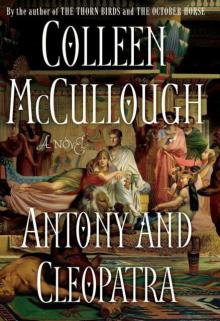 Antony and Cleopatra
Antony and Cleopatra The First Man in Rome
The First Man in Rome Caesar
Caesar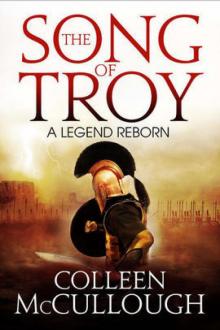 The Song of Troy
The Song of Troy Fortune's Favorites
Fortune's Favorites The Touch
The Touch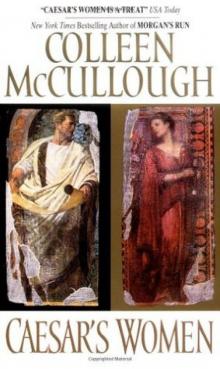 Caesar's Women
Caesar's Women The Independence of Miss Mary Bennet
The Independence of Miss Mary Bennet The Grass Crown
The Grass Crown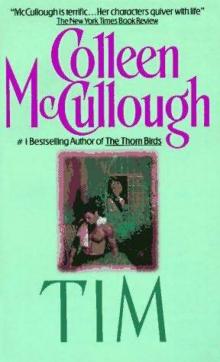 Tim
Tim Bittersweet
Bittersweet Angel
Angel 3. Fortune's Favorites
3. Fortune's Favorites Sins of the Flesh
Sins of the Flesh 2. The Grass Crown
2. The Grass Crown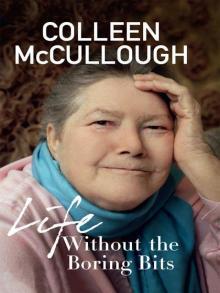 Life Without The Boring Bits
Life Without The Boring Bits Masters of Rome Boxset: First Man in Rome, the Grass Crown, Fortune's Favourites, Caesar's Women, Caesar
Masters of Rome Boxset: First Man in Rome, the Grass Crown, Fortune's Favourites, Caesar's Women, Caesar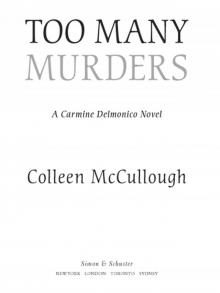 Too Many Murders
Too Many Murders 1. First Man in Rome
1. First Man in Rome On, Off
On, Off 5. Caesar
5. Caesar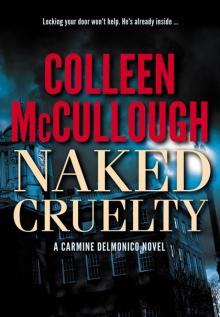 Naked Cruelty
Naked Cruelty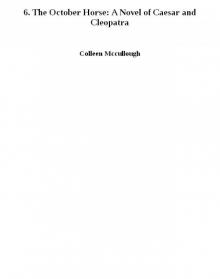 6. The October Horse: A Novel of Caesar and Cleopatra
6. The October Horse: A Novel of Caesar and Cleopatra